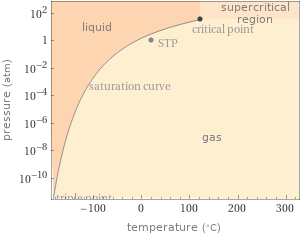Input interpretation

2-chloro-1, 1, 1, 2-tetrafluoroethane | freezing point
Result

-117.2 °C (degrees Celsius)
Phase diagram

Phase diagram
Units

Unit conversions

155.9 K (kelvins)

-179 °F (degrees Fahrenheit)

280.7 °R (degrees Rankine)

-93.76 °Ré (degrees Réaumur)

-54.03 °Rø (degrees Rømer)
Comparisons as temperature

23 °C below coldest recorded temperature on Earth (-94.7 °C)

18 °C above Hg-Tl-Ba-Ca-Cu-oxide superconducting temperature (138 K)

31 °C above Tl-Ba-Cu-oxide superconducting temperature (125 K)
Corresponding quantities

Thermodynamic energy E from E = kT: | 13 meV (millielectronvolts)

Blackbody energy flux Φ from Φ = σT^4: | 34 W/m^2 (watts per square meter)

Approximate luminous exitance from a planar blackbody radiator perpendicular to its surface: | 6.1×10^-47 lx (lux)